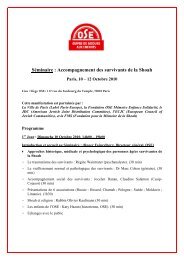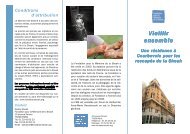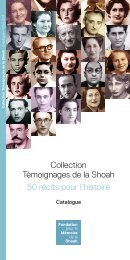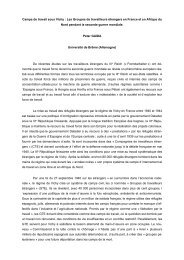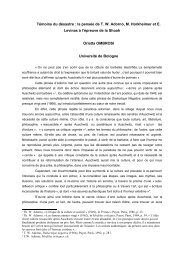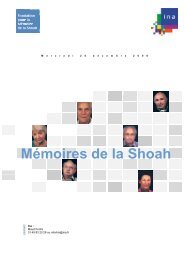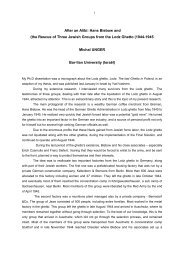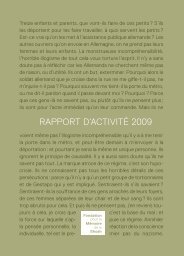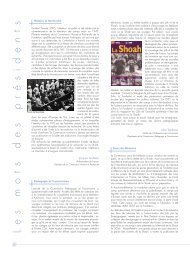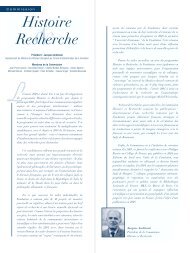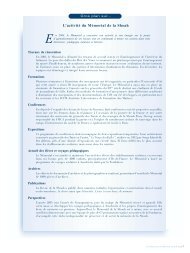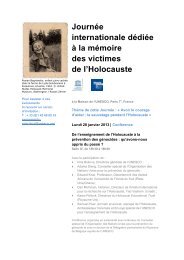Daniel Brewing, M.A. In the Shadow of Auschwitz In a recent article ...
Daniel Brewing, M.A. In the Shadow of Auschwitz In a recent article ...
Daniel Brewing, M.A. In the Shadow of Auschwitz In a recent article ...
You also want an ePaper? Increase the reach of your titles
YUMPU automatically turns print PDFs into web optimized ePapers that Google loves.
<strong>Daniel</strong> <strong>Brewing</strong>, M.A. <strong>In</strong> <strong>the</strong> <strong>Shadow</strong> <strong>of</strong> <strong>Auschwitz</strong><br />
<strong>In</strong> a <strong>recent</strong> <strong>article</strong> for <strong>the</strong> London Review <strong>of</strong> Books, British historian Richard Evans<br />
concluded his deliberations on <strong>the</strong> 20 th century European history <strong>of</strong> violence with <strong>the</strong><br />
following statement: “What we need is to understand why <strong>the</strong> murder <strong>of</strong> Poles took<br />
place and how people could carry it out.” 1 Therefore, my dissertation project is a<br />
thick exploration <strong>of</strong> German mass violence against <strong>the</strong> ethnic Polish civilian<br />
population in <strong>the</strong> occupied Polish territories during World War II. I use wartime<br />
documentation, survivors’ testimonies, and both German and Polish records <strong>of</strong><br />
postwar criminal investigations to trace <strong>the</strong> historical processes that resulted in <strong>the</strong><br />
deaths <strong>of</strong> hundreds <strong>of</strong> thousands <strong>of</strong> ethnic Polish civilians.<br />
This paper seeks to highlight (1) <strong>the</strong> status <strong>of</strong> research and (2) <strong>the</strong> project’s<br />
methodological and <strong>the</strong>oretical approach, and present (3) preliminary findings and<br />
historiographical contributions.<br />
Status <strong>of</strong> Research<br />
The German occupation <strong>of</strong> Poland has been covered in a vast amount <strong>of</strong><br />
historiographical literature. Adjacent to structural historical syn<strong>the</strong>ses 2 and source<br />
editions, 3 historians mainly focused on studies <strong>of</strong> particular policies <strong>of</strong> German rule, 4<br />
and published numerous studies on <strong>the</strong> German occupation apparatus. 5<br />
The historical research approached <strong>the</strong> special object <strong>of</strong> mass violence in occupied<br />
Poland from two perspectives. Since <strong>the</strong> early 1990s, a growing international<br />
scholarship analyzed <strong>the</strong> complex implementation <strong>of</strong> anti-Jewish violence, while <strong>the</strong><br />
1 Evans, Richard J. : Who remembers <strong>the</strong> Poles ?, in : London Review <strong>of</strong> Books, Vol. 32, Nr. 21, 4<br />
November 2010.<br />
2 Madajczyk, Czesław: Polityka III Rzeszy w okupowanej Polsce, 2 vol., Warszawa 1970; Łuczak,<br />
Czesław: Polityka ludnościowa I ekonomiczna hitlerowskich Niemiec w okupowanej Polsce, Poznań<br />
1993; Broszat, Martin: Nationalsozialistische Polenpolitik 1939-1945, Stuttgart 1961; Eisenblätter,<br />
Gerhard: Grundlinien der Politik des Reiches gegenüber dem Generalgouvernement 1939-1944, Diss.<br />
Phil., Frankfurt a. M. 1969.<br />
3 Documenta Occupationis, Poznań 1945-1990; Röhr, Werner (ed.): Die faschistische<br />
Okkupationspolitik in Polen 1939-1945, Berlin (Ost) 1989 (=Europa unter dem Hakenkreuz, vol. 2).<br />
4 A comprehensive study on German agricultural policy is: Rajca, Czesław: Walka o chleb 1939-1945.<br />
Eksploatacja rolnictwa w Generalnym Gubernatorstwie, Lublin 1991; for <strong>the</strong> germanization and<br />
settlement policy: Aly, Götz/Heim, Susanne: Vordenker der Vernichtung. <strong>Auschwitz</strong> und die Pläne<br />
für eine neue europäische Ordnung, Hamburg 1990.<br />
5 For <strong>the</strong> SS and police apparatus, see: Borodziej, Włodzimierz: Terror I polityka. Policja niemiecka a<br />
polski ruch oporu w GG 1939-1944, Warszawa 1985; for <strong>the</strong> Wehrmacht , see: Radziwończyk,<br />
Kazimierz: Niemieckie siły zbrojne w okupowanej Polsce, 22.6.1941-wiosną 1944 r., in: Wojskowy<br />
Przegląd Historyczny 7, 3 (1962), pp. 103-159 and 7, 4 (1962), pp. 31-96; for <strong>the</strong> civil administration,<br />
see: Kaczmarek, Ryszard: Pod rządami Gauleiterów. Elity I instancje władze w rejencji w latach 1939-<br />
1945, Katowice 1998.
<strong>Daniel</strong> <strong>Brewing</strong>, M.A. <strong>In</strong> <strong>the</strong> <strong>Shadow</strong> <strong>of</strong> <strong>Auschwitz</strong><br />
significantly older Polish research has focused on <strong>the</strong> suffering <strong>of</strong> <strong>the</strong> ethnic Polish<br />
civilian population.<br />
(a) Drawing upon hi<strong>the</strong>rto unexplored archival material, scholars <strong>of</strong> <strong>the</strong> Shoah have<br />
focused on <strong>the</strong> implementation <strong>of</strong> genocidal policies at <strong>the</strong> actual sites <strong>of</strong> mass<br />
murder in occupied Poland, turning away from <strong>the</strong> sterile debates on <strong>the</strong> decision-<br />
making process within <strong>the</strong> Berlin central agencies. A number <strong>of</strong> regional studies that<br />
cover nearly <strong>the</strong> entire Polish territories sketched a highly complex picture <strong>of</strong><br />
numerous agencies with multifaceted motivations, perpetrating violent measures<br />
against Jews with utter brutality. 6 Within <strong>the</strong> context <strong>of</strong> Holocaust research, <strong>the</strong> role<br />
<strong>of</strong> <strong>the</strong> Polish civilian population – ra<strong>the</strong>r unsurprisingly – remained blurry. We can<br />
identify just three analytical approaches in which Historians paid attention to Polish<br />
civilians: First, in so-called new population studies, where <strong>the</strong> Holocaust is<br />
historicized both into <strong>the</strong> context <strong>of</strong> ethnic cleansing in <strong>the</strong> first half <strong>of</strong> <strong>the</strong> twentieth<br />
century and Nazi schemes for postwar demographic reordering. 7 Second, Poles<br />
appear in <strong>the</strong> context <strong>of</strong> interpretations <strong>of</strong> <strong>the</strong> Holocaust as a Germany-driven<br />
European project, in which <strong>the</strong> indigenous population participated for numerous<br />
reasons. 8 Third, finally, in approaches which highlight <strong>the</strong> contrary processes and ask<br />
for <strong>the</strong> conditions, possibilities and dimensions <strong>of</strong> rescuing Jews. 9 Thus, within <strong>recent</strong><br />
patterns <strong>of</strong> research <strong>the</strong> situation <strong>of</strong> Polish civilians under German rule remains<br />
understudied as it hardly ever appears at <strong>the</strong> center <strong>of</strong> research on Nazi violence.<br />
6 Pohl, Dieter: Von der „Judenpolitik“ zum Judenmord. Der Distrikt Lublin des<br />
Generalgouvernements 1939-1944, Frankfurt a. M. 1993; Sandkühler, Thomas: „Endlösung“ in<br />
Galizien. Der Judenmord in Ostpolen und die Rettungsinitiativen von Berthold Beitz, 1941-1944, Bonn<br />
1996; Gerlach, Christian: Krieg, Ernährung, Völkermord. Forschungen zur deutschen<br />
Vernichtungspolitik im Zweiten Weltkrieg, Hamburg 1998; Musial, Bogdan: Deutsche<br />
Zivilverwaltung und Judenverfolgung im Generalgouvernement. Eine Fallstudie zum Distrikt Lublin<br />
1939-1944, Wiesbaden 1999; Alberti, Michael: Die Verfolgung und Vernichtung der Juden im<br />
Reichsgau War<strong>the</strong>land 1939-1945, Wiesbaden 2006; Młynarczyk, Jacek Andrzej: Judenmord in<br />
Zentralpolen. Der Distrikt Radom des Generalgouvernements 1939-1945, Darmstadt 2007.<br />
7 Aly, Götz: „Endlösung“. Völkerverschiebung und der Mord an den europäischen Juden, Frankfurt a.<br />
M. 1995 ; Bloxham, Donald : Holocaust. A Genocide, Oxford 2009; Levene, Mark: Genocide in <strong>the</strong> Age<br />
<strong>of</strong> <strong>the</strong> Nation-State, London 2005; Kieser, Hans-Lukas/Schaller, Dominik: Völkermord im historischen<br />
Raum 1895-1945, in: dies. (Hrsg.): Der Völkermord an den Armeniern und die Shoah, Zürich 2002, S.<br />
11-80; Heinemann, Isabel/Wagner, Patrick (Hrsg.): Wissenschaft - Planung - Vertreibung.<br />
Neuordnungskonzepte und Umsiedlungspolitik im 20. Jahrhundert, Stuttgart 2006.<br />
8 For example : Gross, Jan Tomasz. Nachbarn. Der Mord an den Juden von Jedwabne, München 2001;<br />
and by <strong>the</strong> same author : Golden Harvest, Oxford 2011 ; Grabowski, Jan: „Ja tego Żyda znam!“.<br />
Szantażowanie Żydów w Warszawie 1939-1943, Warszawa 2004.<br />
9 For example : Kosmala, Beate : Ungleiche Opfer in einer extremen Situation – Die Schwierigkeiten<br />
der Solidarität im besetzten Polen, in : Benz, Wolfgang/Wetzel, Juliane (Hrsg.) : Solidarität und Hilfe<br />
für Juden während der NS-Zeit, Berlin 1996.
<strong>Daniel</strong> <strong>Brewing</strong>, M.A. <strong>In</strong> <strong>the</strong> <strong>Shadow</strong> <strong>of</strong> <strong>Auschwitz</strong><br />
(b) <strong>In</strong> contrast, <strong>the</strong> Polish scholarship on mass violence against ethnic Poles stagnated<br />
in a positivistic tendency <strong>of</strong> description. Predominantly relying on survivors’<br />
testimonies, Polish historians mainly documented German atrocities on <strong>the</strong> local<br />
level. The framework for <strong>the</strong> interpretation <strong>of</strong> <strong>the</strong>se murderous events remained<br />
simple: Polish historians generally ascribed <strong>the</strong> acts <strong>of</strong> violence to long-term<br />
intentional measures for <strong>the</strong> “biological extermination <strong>of</strong> <strong>the</strong> Polish nation.” 10 <strong>In</strong><br />
consequence, both <strong>the</strong> German decision-making and <strong>the</strong> central mechanisms <strong>of</strong><br />
escalation remained excluded. 11 Finally, in western historiography mass crimes<br />
against ethnic Poles have been widely left out <strong>of</strong> scholarly inquiry. 12 Only in <strong>the</strong> last<br />
five years, have German and American scholars begun to hesitantly trace this subject<br />
among o<strong>the</strong>rs by analyzing <strong>the</strong> first months <strong>of</strong> German rule in Poland. 13<br />
Therefore, my project’s aims are three-fold. First, I will widen <strong>the</strong> temporal<br />
parameters <strong>of</strong> research by focusing on <strong>the</strong> entire period <strong>of</strong> German occupation in<br />
Poland from 1939 to 1945, to stress mechanisms <strong>of</strong> long-term radicalization. Second, I<br />
will push <strong>the</strong> boundaries <strong>of</strong> Polish historical research to <strong>the</strong> multi-dimensional<br />
approach <strong>of</strong> Shoah scholarship. Lastly, my approach will open up <strong>the</strong> possibility to<br />
highlight mutual influences and transfers between <strong>the</strong> two violent complexes.<br />
Thereby, my project will contribute to Shoah scholarship by sharpening <strong>the</strong> context<br />
<strong>of</strong> mass violence in occupied Poland.<br />
10 Madajczyk, Polityka III Rzeszy.<br />
11 This is true for <strong>the</strong> monumental syn<strong>the</strong>ses: Madajczyk, Polityka III Rzeszy; Łuczak, Polityka;<br />
fur<strong>the</strong>rmore, see especially <strong>the</strong> numerous descriptive <strong>article</strong>s on mass crimes in <strong>the</strong> pertinent journals:<br />
Biuletyn Głównej Komisji Badania Zbrodni Niemieckich (later: Hitlerowskich) w Polsce, 1946 ff.; since<br />
1991: Biuletyn Komisji Badania Zbrodni przeciwko Narodowi Polskiemu; now: Pamięć i<br />
Sprawiedliwość; see as well: Dzieje Najnowsze, Wojskowy Przegląd Historyczny, Przegląd<br />
Historyczny.<br />
12 The only exception was <strong>the</strong> purely polemical account by American scholar Richard C. Lukas which<br />
is full flaws but unfortunately still serves as <strong>the</strong> referential point for <strong>the</strong> scholarly community. See:<br />
Lukas, Richard, C.: The Forgotten Holocaust: The Poles under German occupation 1939-1944,<br />
Lexington 1986.<br />
13 For <strong>the</strong> Polish campaign in September 1939, two dissertations were published in <strong>the</strong> last years. See:<br />
Rossino, Alexander B.: Hitler strikes Poland. Blitzkrieg, Ideology, and Atrocity, Kansas City 2003;<br />
Böhler, Jochen: Auftakt zum Vernichtungskrieg. Die Wehrmacht in Polen 1939, Frankfurt a. M. 2006;<br />
see as well with a specific focus on police units during <strong>the</strong> Polish campaign: Mallmann, Klaus-<br />
Michael/Böhler, Jochen/Matthäus, Jürgen: Einsatzgruppen in Polen. Darstellung und<br />
Dokumentation, Darmstadt 2008; focusing on <strong>the</strong> first months <strong>of</strong> <strong>the</strong> occupation are <strong>the</strong> case studies<br />
in: Mallmann, Kaus-Michael/Musial, Bogdan (ed.): Genesis des Genozids. Polen 1939-1941,<br />
Darmstadt 2004; most <strong>recent</strong>ly, Philip T. Ru<strong>the</strong>rford published his excellent dissertation on <strong>the</strong><br />
deportations <strong>of</strong> Poles from <strong>the</strong> western Polish territories to <strong>the</strong> Generalgovernment, see: Ru<strong>the</strong>rford,<br />
Philip T.: Prelude to <strong>the</strong> Final Solution: The Nazi Program for Deporting Ethnic Poles, 1939-1941,<br />
Lawrence 2007.
<strong>Daniel</strong> <strong>Brewing</strong>, M.A. <strong>In</strong> <strong>the</strong> <strong>Shadow</strong> <strong>of</strong> <strong>Auschwitz</strong><br />
Theoretical approach<br />
My own approach is informed by three simple observations: First, <strong>the</strong> Holocaust as<br />
<strong>the</strong> racial political core <strong>of</strong> Nazi ideology reflects <strong>the</strong> patterns <strong>of</strong> o<strong>the</strong>r processes and<br />
contexts <strong>of</strong> Nazi persecution and mass violence. Thus violence against ethnic Poles<br />
cannot be conceived properly as <strong>the</strong> exclusive result <strong>of</strong> a consistent implementation<br />
<strong>of</strong> intentional measures. 14 Second, ideology is not sufficient to explain mass violence,<br />
since <strong>the</strong> connection between attitude and action is only a loose one, and racism does<br />
not necessarily press for its violent implementation. 15 Third, collective violence<br />
develops through <strong>of</strong>fers to act by central agencies and initiatives from <strong>the</strong> regional<br />
and local level. 16<br />
Against this background, occupied Poland constituted, in my view, a specific area for<br />
<strong>the</strong> perpetration <strong>of</strong> violence. This area was formed through constantly changing<br />
constellations <strong>of</strong> transgressions and restraints that created a frame in which <strong>the</strong><br />
German personnel in occupied Poland had to operate. The decisive parameters <strong>of</strong><br />
this area were set by a structural transgression from above, that turned violence into<br />
a cornerstone <strong>of</strong> <strong>the</strong> German future in which <strong>the</strong> “Volksgemeinschaft” would rule<br />
over a racially homogenous Eastern Europe. 17 Due to this perception <strong>the</strong> Germans<br />
installed an order <strong>of</strong> violence, that transcended traditional patterns <strong>of</strong> occupation,<br />
and ra<strong>the</strong>r aimed at <strong>the</strong> de-nationalizing <strong>the</strong> Polish society in order to produce a<br />
people without rights. 18 At <strong>the</strong> same time, this transgression from above, opened up<br />
specific zones for social action, in which <strong>of</strong>fers for violent initiatives were made and<br />
chances for violent action were made, which, in turn, were accepted and used widely<br />
within <strong>the</strong> German occupation society. 19 Hence, violence in <strong>the</strong> German East was not<br />
14<br />
Matthäus, Jürgen: Holocaust und Antisemitismus: Spezifika, Disparitäten, Zusammenhänge,<br />
unpublished paper given at <strong>the</strong> Zentrum für Antisemitismusforschung, July 2008.<br />
15<br />
Welzer, Harald: Täter. Wie aus ganz normalen Menschen Massenmörder werden, Frankfurt am<br />
Main 2005; Geulen, Christian: Geschichte des Rassismus, München 2007.<br />
16 Kundrus, Bir<strong>the</strong>: Entscheidung für den Völkermord. Einleitende Überlegungen zu einem<br />
historiographischen Problem, in: Mittelweg 36, 6 (2006), pp. 4-17.<br />
17<br />
Baberowski, Jörg/Doering-Manteuffel, Anselm: Ordnung durch Terror. Gewaltexzesse und<br />
Vernichtung im nationalsozialistischen und stalinistischen Imperium, Bonn 2006, S. 59 ff.<br />
18<br />
Geyer, Michael/Jarausch, Konrad: Zerbrochener Spiegel. Deutsche Geschichten im 20. Jahrhundert,<br />
München 2005, S. 160 ff.<br />
19 For example : Mallmann, Klaus-Michael: „Mensch, ich feiere heut‘ den tausendsten Genickschuß.“<br />
Die Sicherheitspolizei und die Shoah in Westgalizien, in: Musial, Bogdan (Hrsg.): „Aktion Reinhardt“.<br />
Der Völkermord an den Juden im Generalgouvernement 1941-1944, Osnabrück 2004, S. 353-379.
<strong>Daniel</strong> <strong>Brewing</strong>, M.A. <strong>In</strong> <strong>the</strong> <strong>Shadow</strong> <strong>of</strong> <strong>Auschwitz</strong><br />
a deviant behavior but could instead meet collective expectations and could be in<br />
conformity with <strong>the</strong> collective norms <strong>of</strong> <strong>the</strong> German occupation society. 20<br />
This does not imply, though, that every kind <strong>of</strong> violence against ethnic Poles would<br />
have been accepted or allowed. Ra<strong>the</strong>r, <strong>the</strong> area <strong>of</strong> action in occupied Poland was<br />
formed through a number <strong>of</strong> imperatives and restrictions that at first sight would<br />
appear highly inconsistent. But we are faced with a closely meshed set <strong>of</strong> rules that<br />
all German agents were subjected to, and that was guarded by different civilian and<br />
SS-Police courts. 21 Specific red lines were drawn-in, that marked <strong>the</strong> oscillating<br />
borders between allowed violent behavior and prohibited violence. That way, <strong>the</strong><br />
violence was supposed to be channeled into regulated forms <strong>of</strong> action in order both<br />
to avoid independent excesses or “Ausschweifungen” and to secure a stabile<br />
normative frame that would avoid an anarchic escalation <strong>of</strong> violence. Fur<strong>the</strong>rmore,<br />
this normative framework was supposed to secure <strong>the</strong> economic rationality <strong>of</strong><br />
violence and to avoid a negative impact on highly important economy <strong>of</strong> occupied<br />
Poland. But <strong>the</strong> new research on <strong>the</strong> perpetrators <strong>of</strong> Nazi violence has clearly shown<br />
that this normative framework certainly did not mirror <strong>the</strong> reality “on <strong>the</strong> ground”,<br />
but ra<strong>the</strong>r needs to be interpreted as a desired status. 22 Within <strong>the</strong> specific milieus <strong>of</strong><br />
<strong>the</strong> German East with its safeguarding comradeship <strong>the</strong> normative red lines could<br />
easily be crossed by various agents in deliberate acts <strong>of</strong> self-authorization. 23 The<br />
motivating factors for crossing <strong>the</strong> lines were anthropological constants such as fear,<br />
insecurity and hate as well as ideological commitment, racism, and radical-<br />
nationalism.<br />
<strong>In</strong> order to understand German violence against ethnic Poles, we need to take a<br />
closer look at <strong>the</strong> specific areas <strong>of</strong> action that were formed by both normative<br />
20 Jäger, Herbert: Verbrechen unter totalitärer Herrschaft. Studien zur nationalsozialistischen<br />
Gewaltkriminalität, Olten/Freiburg i. Brsg. 1967; ders.: Makrokriminalität. Studien zur Kriminologie<br />
kollektiver Gewalt, Frankfurt a. M. 1989<br />
21 Scheffler, Wolfgang: Zur Praxis der SS- und Polizeigerichtsbarkeit im Dritten Reich, in: Doeker,<br />
Gün<strong>the</strong>r/Steffani, Winfried (Hrsg.): Klassenjustiz und Pluralismus. Festschrift für Ernst Fraenkel,<br />
Hamburg 1973, S. 224-236; Wegner, Bernd: Die Sondergerichtsbarkeit von SS und Polizei. Militärjustiz<br />
oder Grundlegung einer SS-gemäßen Rechtsordnung, in: Büttner, Ursula: Das Unrechtsregime.<br />
<strong>In</strong>ternationale Forschung über den Nationalsozialismus. Festschrift für Werner Jochmann zum 65.<br />
Geburtstag, Bd. 1, Hamburg 1986, S. 243-259.<br />
22 See for example <strong>the</strong> contributions in : Mallmann, Klaus-Michael/Paul, Gerhard : Karrieren der<br />
Gewalt. Nationalsozialistische Täterbiographien, Darmstadt 2004.<br />
23 Lehnstaedt, Stephan : Okkupation im Osten. Besatzeralltag in Warschau und Minsk 1939-1944,<br />
München 2010.
<strong>Daniel</strong> <strong>Brewing</strong>, M.A. <strong>In</strong> <strong>the</strong> <strong>Shadow</strong> <strong>of</strong> <strong>Auschwitz</strong><br />
transgression and attempts to regulate from above and <strong>the</strong> self-authorization <strong>of</strong><br />
agents defining what is permitted, prohibited and ordered in this area. This<br />
combination produced a constantly high level <strong>of</strong> violence that left behind destroyed<br />
landscapes and millions <strong>of</strong> dead.<br />
Preliminary findings and contributions<br />
My dissertation project is an innovative approach to <strong>the</strong> historical study <strong>of</strong> <strong>the</strong><br />
violent German occupation in Eastern Europe that will broaden, amend, and correct<br />
in many respects <strong>the</strong> scholarly understanding <strong>of</strong> German rule in Poland, and “<strong>the</strong><br />
East”. <strong>In</strong> my paper I would like to highlight just six relevant new vistas which my<br />
project discloses.<br />
(1) Violence against ethnic Poles developed within a broader framework <strong>of</strong> long-,<br />
middle- and short-term objectives which were set by <strong>the</strong> top level leadership. Over<br />
time, this framework generated both intentional and situational violence against <strong>the</strong><br />
civilian population. Within this framework, Nazi violence unfolded through <strong>the</strong><br />
entanglement <strong>of</strong> warfare, racial restructuring, economic, agrarian, and security<br />
policies.<br />
(2) The inherent conflicts and opposing interests within <strong>the</strong> different branches <strong>of</strong> <strong>the</strong><br />
occupation apparatus caused numerous contradictions, which in turn produced<br />
crucial variations in both <strong>the</strong> intensity and <strong>the</strong> focus <strong>of</strong> violence over time.<br />
(3) Violence against ethnic Poles was a product <strong>of</strong> transfers between different agents<br />
and institutions all over German occupied Eastern Europe. Know-how on specific<br />
forms and methods <strong>of</strong> violence was transmitted especially within <strong>the</strong> SS apparatus<br />
but also included <strong>the</strong> civilian administration and <strong>the</strong> German army. This exchange<br />
transcended <strong>the</strong> classic center/periphery pattern as within and beyond <strong>the</strong> SS<br />
apparatus traditional elements <strong>of</strong> hierarchical formalism lost <strong>the</strong>ir importance. <strong>In</strong> <strong>the</strong><br />
occupied Polish territories, <strong>the</strong> German personnel interacted vertically, horizontally<br />
and diagonally. This interaction created a dynamic, ever more borderless exchange <strong>of</strong><br />
violent methods and experts on violence.<br />
(4) Violence against ethnic Poles was, at least partially, a product <strong>of</strong> complex<br />
processes <strong>of</strong> interaction between <strong>the</strong> German occupiers and occupied Poles<br />
<strong>the</strong>mselves. A closer look at <strong>the</strong> local level reveals mechanisms <strong>of</strong> cooperation in field
<strong>Daniel</strong> <strong>Brewing</strong>, M.A. <strong>In</strong> <strong>the</strong> <strong>Shadow</strong> <strong>of</strong> <strong>Auschwitz</strong><br />
<strong>of</strong> common interests that could for example include <strong>the</strong> perpetration <strong>of</strong> violence<br />
against partisans. <strong>In</strong> this perspective <strong>the</strong> perpetration <strong>of</strong> violence against ethnic Poles<br />
resulted in part from a complex scenario with multiple agents, including bystanders,<br />
perpetrators and pr<strong>of</strong>iteers that acted out <strong>of</strong> a variety <strong>of</strong> motivations, including<br />
inner-Polish prewar political constellations.<br />
(5) Violence against ethnic Poles took a specific form when so-called “Volksdeutsche”<br />
were involved. They <strong>of</strong>ten participated in <strong>the</strong> selection processes before <strong>the</strong> shootings<br />
and were encouraged to select among <strong>the</strong>ir Polish neighbors those with purportedly<br />
“anti-German-attitudes”. This procedure secured legitimacy for <strong>the</strong> killings among<br />
“Volksdeutsche” and violently introduced racial difference into <strong>the</strong> relations <strong>of</strong> Poles<br />
and “Volkdeutsche” in small communities.<br />
(6) Violence against ethnic Poles was intimately linked to parallel mass murders<br />
through institutional, organizational, personal, and conceptual interconnections.<br />
Violence against ethnic Poles is located within <strong>the</strong> overlapping structures <strong>of</strong> violence<br />
against different victim groups; <strong>of</strong> special importance are <strong>the</strong> interrelations, and<br />
verifiable adaptations among <strong>the</strong> mass crimes against ethnic Poles and both <strong>the</strong><br />
Shoah and <strong>the</strong> ´war <strong>of</strong> annihilation´ against <strong>the</strong> Soviet Union. For example in <strong>the</strong><br />
rural areas <strong>of</strong> occupied Poland, German anti-partisan warfare initially aimed Soviet<br />
Prisoners <strong>of</strong> War who had fled from <strong>the</strong> deadly POW camps all over occupied<br />
Poland, soon, though, turned against <strong>the</strong> Polish rural population, and finally was<br />
used as a vital tool in <strong>the</strong> annihilation <strong>of</strong> <strong>the</strong> Polish Jewry. Elucidating <strong>the</strong><br />
entanglement <strong>of</strong> <strong>the</strong>se different strands <strong>of</strong> persecution and murder adds fur<strong>the</strong>r<br />
levels <strong>of</strong> complexity to our understanding <strong>of</strong> Nazi violence and advances <strong>recent</strong><br />
discussions on <strong>the</strong> implementation <strong>of</strong> racial policies in Eastern Europe.



